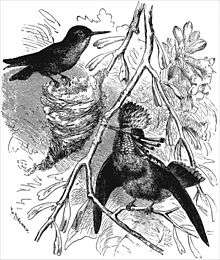Tufted coquette
| Tufted coquette | |
|---|---|
 | |
| Adult male, Asa Wright Nature Centre, Trinidad | |
| Scientific classification | |
| Kingdom: | Animalia |
| Phylum: | Chordata |
| Class: | Aves |
| Order: | Apodiformes |
| Family: | Trochilidae |
| Genus: | Lophornis |
| Species: | L. ornatus |
| Binomial name | |
| Lophornis ornatus (Boddaert, 1783) | |

The tufted coquette (Lophornis ornatus) is a tiny hummingbird that breeds in eastern Venezuela, Trinidad, Guiana, and northern Brazil. It is an uncommon but widespread species, and appears to be a local or seasonal migrant, although its movements are not well understood.
This small bird inhabits open country, gardens, and cultivation. It is 6.6 centimetres (2.6 in) long and weighs 2.3 grams (0.081 oz). The black-tipped red bill is short and straight.
The male tufted coquette is a striking bird. It has a rufous head crest and a coppery green back with a whitish rump band that is prominent in flight. The forehead and underparts are green, and black-spotted rufous plumes project from the neck sides. The tail is golden rufous.
The female lacks the crest and plumes. She has green upperparts (dorsal), except for the whitish tail band, and rufous underparts (ventral) that become much paler on the belly. The tail is mostly bronze green with a dusky band and whitish tips to the feathers. Immature males resemble the female, but their throats are whitish with fine dark spotting.
The female tufted coquette lays two eggs in a small cup nest made of plant down and placed on a branch.
Tufted coquettes are tame and approachable. The call of this species while feeding is a light chik.
Their food is nectar, taken from a variety of flowers, and some small invertebrates. With their small size and steady flight, these birds often resemble a large bee as it moves from flower to flower.
References
- ↑ BirdLife International (2012). "Lophornis ornatus". IUCN Red List of Threatened Species. Version 2013.2. International Union for Conservation of Nature. Retrieved 26 November 2013.
- ffrench, Richard (1991). A Guide to the Birds of Trinidad and Tobago (2nd ed.). Comstock Publishing. ISBN 0-8014-9792-2.
- Hilty, Steven L (2003). Birds of Venezuela. London: Christopher Helm. ISBN 0-7136-6418-5.
External links
- Tufted coquette videos on the Internet Bird Collection
- Stamps (for Guyana, Suriname, Trinidad and Tobago)
- Tufted coquette photo gallery VIREO Photo-High Res
